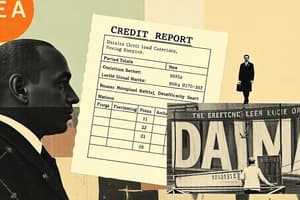Podcast
Questions and Answers
The debt to income ratio compares the buyer’s monthly income against the proposed monthly mortgage and all other regular debt payments.
The debt to income ratio compares the buyer’s monthly income against the proposed monthly mortgage and all other regular debt payments.
True (A)
A primary borrower and a co-borrower each have joint and several liability, meaning that a court may order either one responsible for paying the entire loan balance.
A primary borrower and a co-borrower each have joint and several liability, meaning that a court may order either one responsible for paying the entire loan balance.
True (A)
A person’s net worth equals his assets minus his liabilities.
A person’s net worth equals his assets minus his liabilities.
True (A)
To determine net equity, subtract the value of all liens and selling expenses from the property’s appraised value ($400,000 – $325,000 – $40,000 = $35,000).
To determine net equity, subtract the value of all liens and selling expenses from the property’s appraised value ($400,000 – $325,000 – $40,000 = $35,000).
A person’s credit history, in its narrower sense, describes how many years that person has been borrowing and repaying money.
A person’s credit history, in its narrower sense, describes how many years that person has been borrowing and repaying money.
Most lenders view a loan for a vacation home, a rental property, or a manufactured home as a greater risk.
Most lenders view a loan for a vacation home, a rental property, or a manufactured home as a greater risk.
A co-borrower is solely responsible for paying the entire loan balance.
A co-borrower is solely responsible for paying the entire loan balance.
Net worth is calculated by subtracting assets from liabilities.
Net worth is calculated by subtracting assets from liabilities.
Credit history includes information about how long a person has been borrowing money.
Credit history includes information about how long a person has been borrowing money.
The Equal Credit Opportunity Act allows discrimination against loan applicants receiving income from public assistance.
The Equal Credit Opportunity Act allows discrimination against loan applicants receiving income from public assistance.
Flashcards are hidden until you start studying




